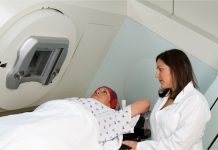 The larynx cancer is also called as laryngeal cancer. Any part of your larynx can be affected.
The larynx cancer is also called as laryngeal cancer. Any part of your larynx can be affected.
Glottis is the place where larynx cancer begins.
The cells that line larynx inner walls are called as squamous cells.
The laryngeal cancer begins in the squamous cells, so the cancer is called as squamous cell carcinoma.
The larynx cancer spreads to the back side of your tongue, lungs, throat, neck, lymph nodes of neck and other parts.
Risk factor of larynx cancer: The exact cause of this cancer is not known. From certain studies it has found that you can affect with certain risk factors that include:
Age: It occurs over the age of 55 in most of the people.
Gender: Men are at higher risk of getting this cancer than women.
Race: It is observed in American and Africans than the Whites.
Smoking: The smokers are at higher risk than the non-smokers. There can be a chance of getting cancer in the neck and head of the person who have larynx cancer, even if they stop smoking.
The larynx cancer symptoms depend up on the area and the tumor size. The other symptoms are:
- Loss of weight
- Breathing problem
- Ear ache
- Voice change or hoarseness
- Lump present in neck
- Frequent coughing
- Sore throat
If you observe these symptoms, then there are some exams in order to diagnose this cancer.
Physical exam: For the presence of lumps and swelling in the lymph nodes, thyroid and larynx of the neck is felt by the doctor. Your tongue is pressed down by the doctor to see the throat.
Direct laryngoscopy: Through your mouth or nose, the light thin tube (laryngoscope) is passed. The doctor can see areas that are not shown in the mirror. The local anesthesia is given to you to prevent discomfort and gagging.
Indirect laryngoscopy: To check the normal function of your vocal cords and abnormal area in larynx, a long or small handed mirror is passed into your throat. This is done under local anesthesia to prevent gagging. This does not harm.
CT scan: The pictures of the neck are taken by linking the computer with the x-ray machine. A special dye injection is given to you so that larynx can be clearly observed. The tumors in the neck or larynx can be observed by CT scan.
Biopsy: The process of removal of the abnormal tissue from the affected area is known as biopsy. For this purpose, the general or local anesthesia can be administered. Laryngoscope is used to remove the tissue sample.
The tissue is then observed under microscope for the cancer cells. This is the only method to find out the tumors of cancer.
Some methods used for the treatment of larynx cancer are surgery, chemotherapy and radiation therapy. The combination of chemotherapy or surgery or the radiation therapy alone can be used to treat the laryngeal cancer.
Larynx cancer can be cured by biopsy, chemotherapy, surgery and radiation therapy.
















